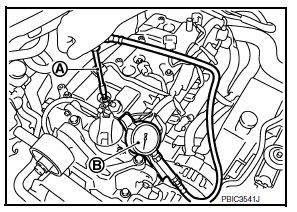Nissan Sentra Service Manual: Compression pressure
Inspection
- Warm up the engine to full operating temperature.
- Release fuel pressure. Refer to EC-143, "Work Procedure".
- Remove ignition coil and spark plug from each cylinder. Refer to EM-46, "Exploded View".
- Connect engine tachometer (not required in use of CONSULT).
- Install compression gauge (B) with an adapter (A) into spark plug hole.

- Use the adapter whose pick up end inserted to spark plug hole is smaller than 20 mm (0.79 in) in diameter. Otherwise, it may be caught by cylinder head during removal.
(a) : 20 mm (0.79 in) or less

- With accelerator pedal fully depressed, turn ignition switch to “START” for cranking. When the gauge pointer stabilizes, read the compression pressure and the engine rpm. Perform these steps to check each cylinder.
Compression pressure : Refer to EM-118, "General Specification".
CAUTION:
Always use a fully charged battery to obtain the specified engine speed.
- If the engine speed is out of the specified range, check battery liquid for proper gravity. Check the engine speed again with normal battery gravity.
- If compression pressure is below minimum value, check valve clearances, and parts associated with combustion chamber (valve, valve seat, piston, piston ring, cylinder bore, cylinder head, and cylinder head gasket). After checking, measure compression pressure again.
- If some cylinder has low compression pressure, pour small amount of engine oil into the spark plug hole of the cylinder to recheck it for compression.
- If the added engine oil improves the compression, piston rings may be worn out or damaged. Check piston rings and replace if necessary.
- If the compression pressure remains at low level despite the addition of
engine oil, valves may be malfunctioning.
Check valves for damage. Replace valve or valve seat accordingly.
- If two adjacent cylinders have respectively low compression pressure and their compression remains low even after the addition of engine oil, cylinder head gaskets are leaking. In such a case, replace cylinder head gaskets.
- After inspection is completed, install removed parts.
- Start the engine, and check that the engine runs smoothly.
- Perform trouble diagnosis. If DTC appears, erase it. Refer to EC-55, "Diagnosis Description".
 Camshaft valve clearance
Camshaft valve clearance
Inspection and Adjustment
INSPECTION
Perform inspection after removal, installation or replacement of camshaft or
valve-related parts, or if there are
unusual engine conditions regarding valve cl ...
Other materials:
The illumination control switch is inoperative
Description
If any of the following malfunctions is found for the illumination control
switch operation.
All switches are inopera
The specified switch cannot be operated
Diagnosis procedure
1.Check illumination control switch signal circuit
Check the illumination control switch signal ...
M&A branch line circuit
Diagnosis procedure
1.Check connector
Turn the ignition switch off.
Disconnect the battery cable from the negative terminal.
Check the terminals and connectors of the combination meter for damage,
bend and loose connection
(unit side and connector side).
Is the inspection result nor ...
P0506 ISC System
Description
The ECM controls the engine idle speed to a specified level through the fine
adjustment of the air, which is let
into the intake manifold, by operating the electric throttle control actuator.
The operating of the throttle valve is
varied to allow for optimum control of the engine ...

